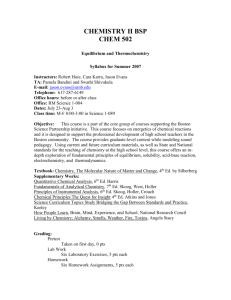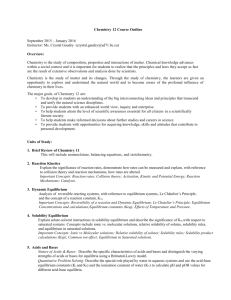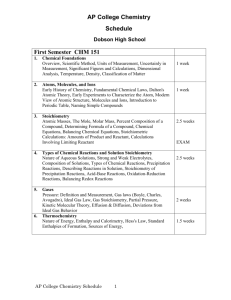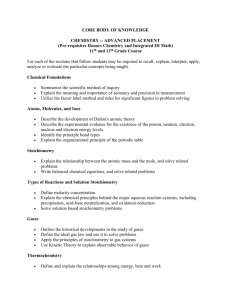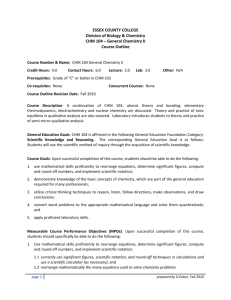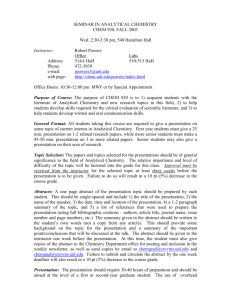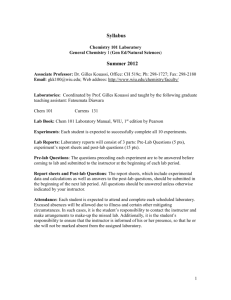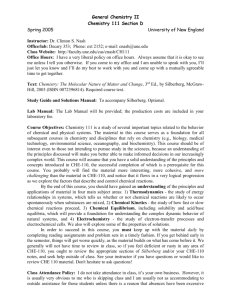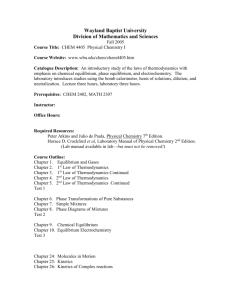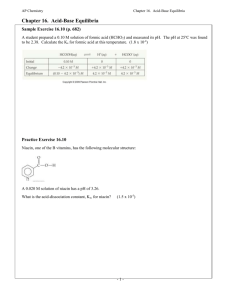Word
advertisement
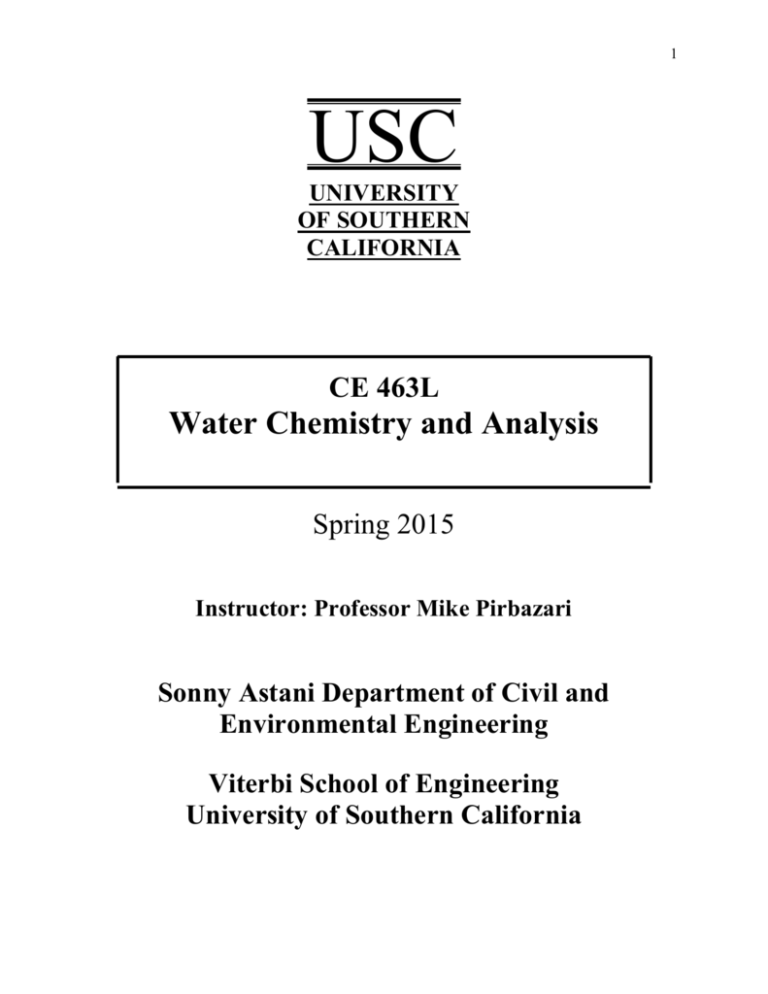
1 USC UNIVERSITY OF SOUTHERN CALIFORNIA CE 463L Water Chemistry and Analysis Spring 2015 Instructor: Professor Mike Pirbazari Sonny Astani Department of Civil and Environmental Engineering Viterbi School of Engineering University of Southern California 2 CE 463L Water Chemistry and Analysis Spring 2015 Course Description: This course teaches the student various aspects of aquatic chemistry with emphasis on water quality relevant to water and wastewater treatment systems. The theoretical aspects include the fundamentals of chemical thermodynamics and kinetics, acid-base reaction equilibria, alkalinity and carbonate systems, and precipitation of solids. Furthermore, it provides a solid foundation on the application of acid-base equilibrium (pC-pH) diagrams and solubility diagrams and other aspects of aquatic chemistry relevant to natural systems and engineered systems. The acid-base chemistry, carbonate systems, and precipitation relate to unit processes such as coagulation and flocculation, precipitation of toxic metals, removal of hardness ,and treatment of industrial wastes. The laboratory classes ensure sufficient exposure to various analytical procedures and techniques pertaining to the quantitative determination of chemical constituents of water including: turbidity and color measurements; jar test studies; inorganics (chloride, sulfate, nitrate, and phosphate ions, and free chlorine), TOC analysis, hardness test (calcium and magnesium ions); carbonate system (bicarbonate and carbonate ions) and alkalinity; acids and bases titration;, biochemical oxygen demand; chemical oxygen demand; and toxic metal analysis. The course familiarizes the student with the use of sophisticated instrumentation to determine these contaminants at various concentration levels. Instructor: (Dr. P) - Professor Mike Pirbazari, Ph.D. Office: Phone: E-mail: KAP 260 213-740-0592 pirbazar@usc.edu Class location: KAP 144 Class hours: Thursday 6:30 to 8:40pm Office hours: Monday: 3:00 to 7:00pm Tuesday: 3:30 to 5:00pm Wednesday: 3:00 to 4:00pm Thursday: 3:00 to 5:00pm (also, by appointment outside these hours) Discussion: Tuesday 5:00 to 6:20pm (KAP 140) Lab Sessions: Tuesday, Wednesday, and Thursday: 1:00 to 3:00pm 3 Lab Location: Laboratory locations - PCE 308 and BHE 210 Teaching Assistant: Woonhoe Kim Office: Phone: E-mail: Office hours: Lab Coordinator: Erick Hernandez Office: Phone: E-mail Grading Criteria: Midterm exam Final exam Quizzes (2 @ 5%) Homework assignments Lab reports Class participation Lab participation Total 15% 20% 10% 15% 25% 7.5% 7.5% --------100% Textbook: Snoeyink, V.L. and Jenkins, D.W., Water Chemistry, John Wiley & Sons, New York, 1980. Class Notes: Pirbazari, M., Class Notes on Lectures and Laboratory Experiments; are Available on Blackboard. 4 References: 1. Sawyer, C.N., McCarty, P.L., and Parkin, G.F., Chemistry for Environmental Engineering and Science, 5th edition, McGraw-Hill, New York, 2003. 2. Standard Methods for the Examination of Water and Wastewater, 20th edition, APHA, AWWA and WPCF, Washington, D.C., 1998. Schedule for Quizzes and Exams: Session Schedule Date 1 2 3 4 5 6 7 8 9 10 11 12 13 14 15 16 01/15 01/22 01/29 02/05 02/12 02/19 02/26 03/05 03/12 03/19 03/26 04/02 04/09 04/16 04/23 05/30 05/07 Quiz 1 Midterm 1 Spring Break Quiz 2 Final Exam: 7:00 to 9:00pm 5 Course Topics I. Introduction (1/2 week) General Properties Water I. Introduction to Water of Chemistry Composition of Different Waters Methods of Expressing Concentrations II. Chemical Equilibrium (1 &1/2 week) Thermodynamic Basis of Chemical Equilibrium Enthalpy, Free Energy, and Equilibrium Constant Non-ideal Behavior of Ions and Molecules in Solution III. Chemical Kinetics (2 weeks) Introduction Reaction Rate Laws Temperature Effect on Reaction Rates Reaction Mechanism Catalysis Empirical Rate Laws IV. Acid-Base Chemistry- Part I- (3 weeks) Equilibrium Calculations - General Approaches Mass Balance, Charge Balance, and Proton Condition Equilibrium Relationships Graphical Techniques for Equilibrium Calculations Effects of Temperature and Ionic Strength on Equilibria V. Acid-Base Chemistry- Part II- (4 weeks) Mixtures of Acids and Base Calculations for pH Determination pH Buffers and Buffer Intensity Carbonate System and Its Equilibria Alkalinity and Acidity Theory of Acid-Base Titration VI. Precipitation and Dissolution- Part I (1 weeks) Equilibria of Dissolution Solubility Product Concept Temperature Effect on Solubility Common ion Effect VII. Precipitation and Dissolution- Part II (2 weeks) Complexation and Solubility Solubility of Salts Solubility Phase Diagrams and Their Applications Ferrous and Ferric Hydroxide and Carbonate systems pCpH diagrams and predominance area diagrams pC-pH 6 VIII. Oxidation-Reduction (1 week) Redox Stoichiometry, Equilibria and Half Reactions Free Energy and Potentials of Half Reactions Nernst Equation and Formation Potentials Electron Balance and Equilibrium Calculations Computer Usage: The use of IBMPC, MacIntosh, PowerMac or equivalent with graphic capabilities are recommended for preparation of laboratory reports. Academic Integrity: The use of unauthorized material, communication with fellow students during an examination, attempting to benefit from the work of another student, and similar behavior that defeats the intent of an examination or other class work is unacceptable to the University. It is often difficult to distinguish between a culpable act and inadvertent behavior resulting from the nervous tension accompanying examinations. When the professor determines that a violation has occurred, appropriate action, as determined by the instructor, will be taken. Although working together is encouraged, all work claimed as yours must in fact be your own effort. Students who plagiarize the work of other students will receive zero points and possibly be referred to Student Judicial Affairs and Community Standards (SJACS). All students should read, understand, and abide by the University Student Conduct Code listed in SCampus, and available at: http://web-app.usc.edu/scampus/university-student-conduct-code/ Students with Disabilities: Any student requesting academic accommodations based on a disability is required to register with Disability Services and Programs (DSP) each semester. A letter of verification for approved accommodations can be obtained from DSP. Please be sure the letter is delivered to your instructor (or to your TA) as early in the semester as possible. DSP is located in STU 301 and is open 8:30 a.m. - 5:00 p.m., Monday through Friday. The phone number for DSP is (213) 740-0776. 7 CE 463L Water Chemistry and Analysis Spring 2015 Laboratory Schedule Session # Date Experiment # Experimental Work 1 Week of Jan. 12th 1 Laboratory Safety Instructions & Overview 2 Week of Jan. 19 th 2 Determination of Turbidity and Coagulant Dosage 3 Week of Jan. 26th 3 Gravimetric Methods for Solids Analysis 4 Week of Feb. 2nd 4 Determination of Organic Pollutant Mixtures by UV Spectroscopy 5 Week of Feb. 9th 5 Determination of Total Organic Carbon by TOC Analyzer 6 Week of Feb. 16th 6 Determination of Inorganic Pollutants by Ion Chromatography 7 Week of Feb. 23rd 8 Week of March 2nd 7 Biochemical Oxygen Demand 9 Week of March. 9th 8 Chemical Oxygen Demand 10 Week of March 16th 11 Week of March 23rd 9 Observation of Activated sludge Microorganisms by Phase Contrast Microscopy 12 Week of March 30st 10 Acid-Base Titration Curves & Acid-Base Indicators 13 Week of April 6th 14 Week of April 13th 11 Alkalinity and Carbonate System 15 Week of April 20th 12 Determination of Hardness by Atomic Absorption Spectroscopy 16 Week of April 27th 13 Lab Review - Becoming Familiar with the Standard Midterm Exam Spring Break No lab Methods for the Examination of Water and Wastewater 8 CE 463L Water Chemistry and Analysis Spring 2015 LABORATORY REPORT INSTRUCTIONS 1. Your laboratory data reports should be presented on 8” x 11” sheets stapled at the lefthand upper corner. 2. All data and experimental write-ups should be word-processed. 3. Laboratory reports will be collected at the beginning of the lab session for the experiment conducted on the previous session. 4. Late laboratory reports will be penalized at 5 points per day. 5. No late report will be accepted one week past the due date. 6. In your laboratory write-up, you must conform to the following format: I - The first page of your laboratory report should contain: LABORATORY REPORT EXPERIMENT # Experiment Title GROUP # YOUR NAME DATE II - Starting from the second page, the write-up must include the following sections: Purpose: (5 pts) Briefly describe the purpose of the lab, and what the lab aims to accomplish. Introduction / Background (10 pts) 9 Elaborate on the purpose, and describe with some detail the lab’s significance to water quality engineering. Provide a detailed technical description of the chemical/physical mechanisms that provide the framework of the experiment. Methods: (10 pts) Briefly describe the experimental procedure. Results / Data:(15 pts) Provide all results obtained during the experiment, this may be data in tabular form, descriptions of observations, or shown in figures (whatever is most appropriate). Clearly label all figures, charts, or tables! Discussion / Questions (when applicable): (40 pts) Discuss the results of the lab and the implications. In this section, tie together the introduction, methods, and results to describe what happened in the experiment and why. If the data appears to be consistent with what was anticipated, describe why this was anticipated and describe the significance. If the results are inconsistent between classmates or what was anticipated, look into why this may have occurred and how the experimental procedure could have been modified improve upon this. This is the most important section of the lab report. In this section you are required to demonstrate a clear understanding of the concepts involved and the chemical/physical mechanisms, which govern the success of the each experiment. Labs may or may not contain questions regarding the experiment and its significance. These questions must be clearly answered using original wording, and if outside references are used, they must be cited appropriately. Conclusion: (20 pts) Briefly summarize the experiment, the results, what was learned, and why it is significant. This should tie everything together in a clear, concise paragraph. Add any final thoughts in this section; please do not simply repeat what was written in previous sections. Additional Note: 10 Please provide original work. All USC plagiarism rules must be observed and will be strictly enforced. Using outside resources to find more information on a subject is encouraged, but make sure to cite them properly. Effective Class Participation Please note the following suggestions for effective class participation: 1) Make every effort to interact with your class partner(s). 2) Try to stay active throughout the class period. 3) Don’t hesitate to ask questions in class. 4) Share your ideas with the rest of us. 5) Don’t hesitate to ask the instructor to repeat himself. 6) Keep an eye on your partner not to fall asleep in class!! 7) Try to bring new ideas to class. 8) Don’t read unrelated materials in class. 9) Share your ideas for class improvement with your instructor. 10) Put your fair share of efforts in preparing the term projects and the term paper. Be cooperative at all times. 11) Discuss your term paper and term project with the instructor periodically. 12) Come to class prepared. 13) Help your instructor make the class interesting. 14) Discuss your concerns and problems (if any) about the course with the instructor. He will do his best to accommodate your suggestions. 15) Late homework is not accepted. 16) Use of lap tops in class is not permitted. 11 17) Tardiness is not acceptable. Effective laboratory Participation Please note the following suggestions for effective lab participation. 1. Follow laboratory safety regulations diligently (posted on Blackboard). 2. Wear your lab coat and safety goggles as soon as you arrive. 3. Bring a copy of the lab procedure with you to class (available on Blackboard). 4. Follow the lab procedure succinctly. 5. Be cooperative at all times. 6. Try not to be disruptive. 7. Don’t hesitate to ask questions. 8. Report accidents to the lab coordinators immediately. 9. Late lab reports are not acceptable. 10. Tardiness is not acceptable. 11. Make every effort to make the lab experience enjoyable for yourself and others. Prepared by: Prof. Mike Pirbazari 12 Date: January 2014
